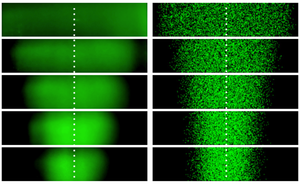Turbulence Can’t Stir Plankton
The mixing effect of fluid turbulence in the ocean should generate a uniform density of microorganisms, but some varieties tend to form clusters instead. In Physical Review Letters, researchers report using experiments and computer simulations to show that a type of plankton will cluster in turbulent fluid because its gravity-sensing system sends it swimming to the center of any vortex. Understanding this clustering may help biologists explain the small-scale patchiness they see in plankton populations, which may affect their reproductive behavior.
With simple appendages, motile microorganisms move through water toward light or a particular nutrient, with their motion directed by any of a wide range of sensing mechanisms, such as rudimentary light detectors or chemical sensors. The plankton Chlamydomonas augustae (a form of green algae) has a “bottom heavy” mass distribution that orients its body to swim up against gravity, a strategy called gyrotaxis. However, this passive steering mechanism can produce unusual collective behavior when the fluid is moving. For example, gyrotactic swimmers will concentrate toward the center of downward-flowing fluid in a pipe [1]. “They are not simple tracers of the water motion,” says Massimo Cencini of the Institute of Complex Systems in Rome.
Cencini and his colleagues recently observed that relatively mild fluid turbulence could cause gyrotactic algae to collect into moving patches [2]. Each cell swam mostly upward against gravity, but if the fluid at the right of a cell was moving downward more rapidly than the fluid to its left, the cell would be twisted a bit toward its right. This slight rotational effect focused the cells’ swimming toward downward-flowing fluid (similar to the earlier pipe experiment). The team has now looked into what happens when the turbulent fluid acceleration is so strong that the resulting inertial forces (such as the centrifugal force we feel in a turning car) compete with gravity.
To verify that fluid motion could “trick” a gyrotactic organism as to which way is up, the researchers placed C. augustae in a rapidly rotating tank. Rather than swimming upward, the organisms moved toward the center, essentially swimming “upstream” against the outward centrifugal force (dead C. augustae spread out uniformly). This result established the dominant role of passive, inertia-based steering, while ruling out contributions from other mechanisms, such as light detection. The researchers then performed computer simulations of these swimmers in highly turbulent waters. They first simulated a turbulent fluid medium inside a cup-sized volume and then randomly introduced a few million plankton “particles” into the water. They programmed these swimmers to move in the direction opposite to the local force, which was a combination of gravity and inertial forces. One would expect turbulence to stir up suspended particles into a uniform distribution, but instead the swimmers clustered in vortices, where the centrifugal force was strongest. The plankton density in the clusters was 10 to 50 times higher than average, with the highest densities in the fastest, most stable vortices. Each cluster lasted only as long as its underlying vortex.
This turbulence-induced clustering could provide some clues as to why motile plankton tend to bunch up more than nonmotile ones. Specifically, biologists have observed certain plankton species congregating in patches that range from kilometer-size down to centimeter-size. At the smaller scales, this patchiness could help plankton find mates for reproduction. The cause of the small-scale patchiness is a mystery, so considering turbulence effects might provide some new insights, Cencini says. He says turbulence may also be important in facilities where algae are grown to make biodiesel and other biofuels. Engineers at these facilities often turbulently mix the algae-rich fluids to avoid sedimentation, but this study shows that this mixing may unwittingly create clusters that could block sunlight to lower parts of the growth tanks.
John Kessler of the University of Arizona in Tucson finds it counterintuitive that turbulence would cause organisms to cluster. He’s not sure where this type of turbulent clustering might appear in nature, but he suspects the turbulence may be strong enough in bays and estuaries or at river mouths. Rachel Bearon from the University of Liverpool, UK, believes the results could help to maximize growth rates at biofuel facilities. “I think the main point to consider is that plankton cannot be simply considered as passive tracers when designing bioreactors,” she says.
–Michael Schirber
Michael Schirber is a Corresponding Editor for Physics Magazine based in Lyon, France.
References
- J. O. Kessler, “Hydrodynamic Focusing of Motile Algal Cells,” Nature 313, 218 (1985)
- W. M. Durham, E. Climent, M. Barry, F. De Lillo, G. Boffetta, M. Cencini, and R. Stocker, “Turbulence Drives Microscale Patches of Motile Phytoplankton,” Nature Commun. 4, 2148 (2013)
More Information
Turbulence “Unmixes” Motile Phytoplankton, from the Human Frontier Science Program





